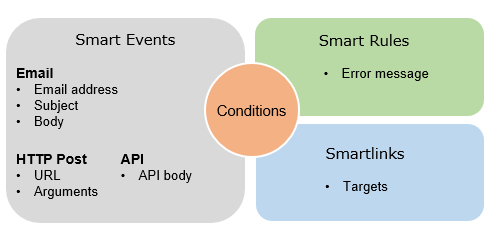- Field lookup is now available for Smart Events, Smart Rules, and Smartlinks
- Queue administration for offline jobs
- Prevent user deletion for improved audit trails
- Deactivate Web Services authorizations
- Warnings no longer block API calls
- MEA allocations
- Uncancel contract lines
- Use contract renewal billing templates on contract lines
- Update and delete other receipts
This release is scheduled to go live on the evening of August 17, 2018 Pacific Time.
Customization Services and Platform Services
Field lookup is now available for Smart Events, Smart Rules, and Smartlinks
You can now select injections from the Sage Intacct UI instead of adding them manually. Creating Smart Events, Smart Rules, and Smartlinks just got a lot easier. For example, the following shows how to use the field lookup when writing a condition for a Smart Rule:

You can use the field lookup to help you write conditions for Smart Rules, Smart Events, and Smartlinks. You can also use this capability when creating the building blocks that comprise these. For example, you can use field lookup for creating Smart Event email addresses, Smart Rule error messages, Smartlink targets, and so forth. The following diagram shows all the places you can use the lookup:

Note that the field lookup lets you access fields for related objects as well as any custom fields.
New SDK for Node.js
Version 1 of the Sage Intacct SDK for Node.js is now available. You can interact with the Web Services gateway using Node.js objects—you no longer need to work directly with the underlying XML API.
You can easily get started with the SDK, then use the reference documentation to go deeper.
Company
Queue administration for offline jobs
Queue administration for offline jobs is now available in the API. You can list your offline job queue and offline job history. You can even take control of your queue and prioritize or cancel jobs if you have the right subscription (Premium Level of Service subscription at Silver level or higher).
An offline job refers to any sort of data action that you choose to process offline in the background while you continue working in Sage Intacct. Offline jobs might include CSV imports, reports, contract invoices, check runs, Data Delivery Service jobs, and more. (Smart Events are not currently supported.)
For more information, see Queue Administration.
Prevent user deletion for improved audit trails
In previous releases, it was possible to delete a user who had been active in the system. In the current release, any user who has been active at least once cannot be deleted. This is needed to preserve the correlation between users and existing logs.
In addition, it is no longer possible to create inactive users.
Web Services
Deactivate Web Services authorizations
Previously, you had to delete a sender ID from your Web Services authorizations list to block the sender ID from making Web Services requests to your company. With the new Status field, you can simply activate or deactivate sender IDs as needed.
Warnings no longer block API calls
In previous releases, an API call that generated a warning message in the system was blocked. Now such warnings will be ignored and the calls will go through.
For example, an API call that would result in a warning due to a future GL posting date will no longer fail and return the warning in the XML response. From now on, only true errors will prevent XML API calls, not warnings due to business logic or other factors.
Contracts and Revenue Management
MEA allocations
You can now create MEA allocations using the API. You can also override system-calculated allocation amounts.
Uncancel contract lines
If you incorrectly or inadvertently canceled a contract line, you can use the new uncancel function to undo that action.
Use contract renewal billing templates on contract lines
A new RENEWALBILLINGTEMPLATENAME parameter lets you specify a billing template on a contract line to associate with the contract line renewal. As an example, if you have a three-year contract but do not want a given contract line to use the billing template for the three-year period, you can use RENEWALBILLINGTEMPLATENAME to specify a template with a shorter term for that line.
For more information about this feature, including default behaviors, see the RENEWALBILLINGTEMPLATENAME parameter on:
Cash Management
Update and delete other receipts
You can now update and delete other receipts using new legacy functions:
Improved documentation for dimension restrictions
The dimensions API documentation has been enhanced to provide more usage information and examples.